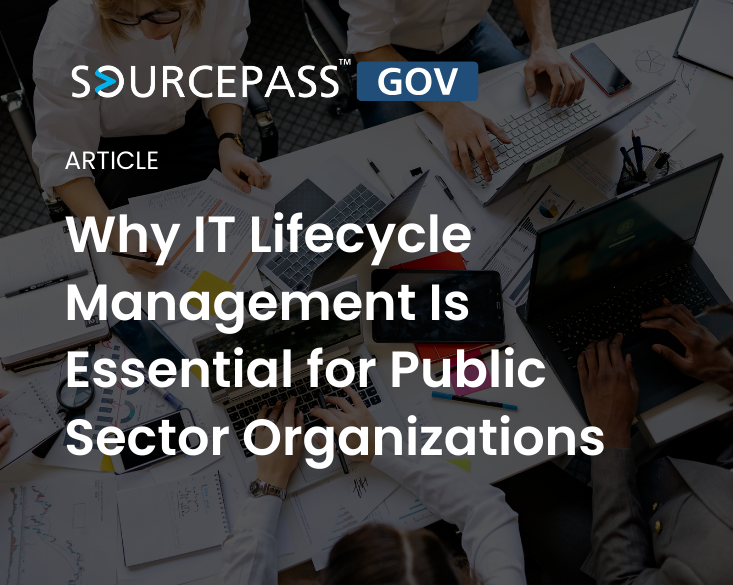1 min read
AI for the Public Sector | Sourcepass GOV AI Trainings
Artificial Intelligence (AI) is transforming how public sector organizations operate, from budgeting and compliance to citizen engagement. In our...
2 min read
Alex Davis : Jan 29, 2025 2:20:42 PM

From local government offices to federal agencies, public sector organizations rely on modern IT systems to deliver services, manage resources, and ensure public safety and communication.
However, managing that lifecycle of technology—from acquisition to replacement and disposal—is crucial for maintaining optimal efficiency, security, and cost-effectiveness.
IT Lifecycle Management (ITLM) is the process of overseeing and optimizing the various stages of an organization's technology assets. This process includes planning, procurement, deployment, maintenance, and eventual decommissioning or replacement.
For public sector organizations like yours, effective ITLM ensures your investments in technology are fully maximized, security risks are mitigated, and public funds are used efficiently.
Let's dive deeper into the reasons IT Lifecycle Management is essential for public sector organizations and how lifecycle management improves and maintains operational efficiency, enhanced security, and sustainability.
Organizations that serve the public often operate with limited budgets that are often under intense scrutiny. IT lifecycle management allows these organizations to better plan and allocate resources for IT purchases, upgrades, and replacements.
By managing the lifecycle of IT assets, public sector organizations can:
Forecast technology needs
Control costs
Maximize asset utilization
Efficient management of IT assets ensures funds are spent where they'll have the greatest impact, reducing waste and enabling the organization to focus on mission-critical goals.
Public sector orgs often handle sensitive data, such as citizens' personal information, financial records, and law enforcement data. The responsibility to protect this information is paramount, going beyond the impact made the organization itself.
IT Lifecycle Management plays a critical role in ensuring that technology systems are secure and compliant with industry regulations and compliance requirements.
Key security benefits of ITLM include:
By implementing IT lifecycle management, public sector organizations can mitigate the risk of cyber threats and ensure compliance with regulatory requirements.
IT systems must operate seamlessly. Outdated or poorly managed technology can lead to inefficiencies, system failures, and operational delays. By adopting an IT lifecycle management strategy, organizations can improve and maintain healthy operational efficiency.
Key benefits include:
With IT Lifecycle Managed, your organization ensures you can deliver critical services without interruption.
The technology landscape is constantly evolving, meaning organizations providing critical services to the public must stay ahead of emerging trends to effectively serve the community.
IT lifecycle management enables organizations to strategically plan for the future -- adopting and replacing new technologies when appropriate.
Key benefits include:
Having a framework in place for technological upgrades and new initiatives enpowers public sector organizations to be forward-thinking and adaptable to future changes.
Transparency, accountability, and public trust are critical when working in public service.
With lifecycle management, your organization effectively demonstrates your commitment to responsible governance and efficient use of resources.
Benefits to public trust include:
Ultimately, efficient management of IT assets helps to foster and maintain trust between public sector organizations and the citizens they serve.
As technology continues to evolve, implementing robust IT lifecycle management practices will be key in sustained operational success.
Ready to start managing your IT? Contact Sourcepass GOV today to learn how partnering with a managed services provider can make the transition easy and low-stress.
.png)
1 min read
Artificial Intelligence (AI) is transforming how public sector organizations operate, from budgeting and compliance to citizen engagement. In our...

3 min read
More than halfway through 2025, state Chief Information Officers (CIOs) continue to navigate a dynamic landscape of technological advancements and...

2 min read
Protecting student data is a top priority for school districts. New York's Education Law §2-d, enacted during the 2014-2015 fiscal year, sets forth...

In today’s rapidly evolving technological landscape, public safety agencies rely on robust communication systems to protect communities and respond...

In 2025, a resilient IT infrastructure is no longer optional for public sector services.

In the public sector, safeguarding your most sensitive data is a top priority. Whether it’s personal information of citizens, private student...